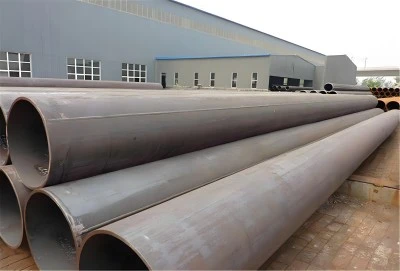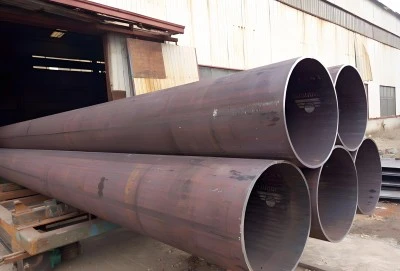Chemical Composition Analysis:
A crucial step in ensuring the suitability and quality of LSAW (Longitudinal Submerged Arc Welded) steel pipes is chemical composition analysis. To determine whether the steel's chemical components meet the requirements for the intended use, this analysis involves evaluating them. The essential parts broke down incorporate carbon, manganese, sulfur, phosphorus, and other alloying components like chromium, nickel, and molybdenum.
The steel's chemical and mechanical properties are significantly influenced by each of these elements. For instance, carbon builds hardness and strength however can likewise make steel weak. Sulfur and phosphorus, on the other hand, can hurt the steel's ductility and weldability if present in excessive amounts. Manganese increases the steel's toughness and resistance to wear.
Optical Emission Spectrometry (OES) and Inductively Coupled Plasma (ICP) spectroscopy are two common methods used to evaluate chemical composition. By providing precise measurements of each component of the steel using these methods, producers can guarantee that the lsaw welded steel pipe complies with industry standards and specifications. Steel pipes with the desired properties and performance characteristics can be produced by manufacturers by adhering to the correct chemical composition.
|
|
|
Mechanical Property Testing:
Mechanical property testing is fundamental for assessing the actual qualities of LSAW welded steel pipe. Elongation, yield strength, and tensile strength measurements are taken during this testing to learn more about the material's behavior under various loading conditions.
Prolongation estimates the material's capacity to twist plastically before breaking. It typically takes the form of a percentage of the original length and is an indication of the ductility of the steel. For applications involving dynamic loads or stress, higher elongation values indicate that the steel pipe can withstand significant deformation without breaking.
Yield Strength is the pressure at which the steel starts to for all time twist. The pipe's capacity to withstand operational pressures and loads without permanently deforming is dependent on this value. It is necessary to ensure that the steel pipe can maintain its structural integrity under anticipated service conditions and is measured in megapascals (MPa).
The maximum stress that steel can withstand before breaking when it is stretched or pulled is referred to as its tensile strength. For applications requiring a high load-bearing capacity, this property is essential. The pipe's overall strength and durability can be assessed using its tensile strength, which is also measured in MPa.
Standard methods like tensile testing machines are used for mechanical property testing, which is necessary to ensure that steel pipes meet the required performance requirements for their intended applications.
Technical Performance Testing:
To guarantee LSAW steel pipes' dependability and safety in use, technical performance testing examines their behavior under a variety of conditions. The Drop Weight Tear Test (DWT), impact test, burst test, and flattening test are among the most important ones.
Drop Weight Tear Test (DWT) surveys the steel line's durability and protection from weak cracks. During this test, a weight is dropped onto the line from a predetermined level to reproduce influence conditions. For applications involving sudden impacts or extreme conditions, the test measures the pipe's capacity to absorb energy and resist cracking.
The material's capacity to absorb energy during a sudden impact is measured in the Impact Test, typically at various temperatures. This test is necessary to guarantee the steel pipe's performance in cold or harsh environments and helps determine the steel pipe's toughness.
The Burst Test includes applying interior strain to the steel pipe until it explodes. This test helps assess the pipe's suitability for high-pressure applications by determining its maximum pressure resistance. The burst test ensures that the pipe will not fail under operating pressures.
By flattening a portion of the steel pipe to a predetermined degree of deformation, the Flattening Test measures the ductility of the pipe. The pipe's capacity to withstand mechanical stresses without cracking or breaking can be evaluated using this test.
Technical performance testing is necessary to make sure that LSAW steel pipes meet the safety and performance requirements for the applications they are intended for. These tests help ensure the pipe's dependability and durability and provide valuable information about how it behaves under various conditions.
X-ray Inspection:
A crucial method for assessing the quality of LSAW welded steel pipe is X-ray inspection. Utilizing industrial X-ray television systems, this method of non-destructive testing finds inclusions, cracks, voids, and other internal defects in the welds.
The steel pipe is subjected to X-rays during X-ray inspection, which penetrate the material and produce an image on a film or digital detector. The resulting image reveals the internal structure of the welds, making it possible for inspectors to locate any flaws or irregularities that could compromise the integrity and performance of the pipe.
The capability of X-ray inspection to provide a comprehensive view of the internal weld structure without causing damage to the pipe is one of its advantages. This approach makes it possible to thoroughly examine and evaluate the quality of the weld, ensuring that any potential issues are identified and addressed before the pipe is put into use.
In practice, X-ray inspection is performed on all LSAW steel pipes to ensure that all welds meet the required quality standards. This extensive methodology forestalls possible disappointments and guarantees that the steel pipes are protected and dependable for their planned applications.
Hydraulic Test:
A crucial step in determining LSAW welded steel pipe pressure resistance is the hydraulic test. The pipe is put through this test by being put under hydraulic pressure to see if it can withstand operational pressures without leaking or failing.
The steel pipe is filled with water or another suitable liquid during the hydraulic test, and pressure is gradually applied until the specified test pressure is reached. After that, any indications of leakage, deformation, or other issues are monitored on the pipe. The test pressure is normally higher than the greatest working strain to guarantee an edge of security.
The pipe's strength and durability under high pressure must be confirmed by the hydraulic test. It contributes to the assurance that the pipe will be able to keep its performance and integrity throughout its service life. Manufacturers can confirm that their LSAW steel pipes meet the required performance standards and are suitable for their intended applications by carrying out stringent hydraulic testing.
LSAW Welded Steel Pipe Supplier:
The Longma Group offers a comprehensive range of LSAW steel pipes, manufactured according to specifications such as ASTM A53 Gr.B, API 5L (Grades B, X42, X46, X52, X56, X60, X65, X70, X80 PSL1 and PSL2), ASTM A252, ASTM A500, AS/NZS 1163, AS/NZS1074, EN10219, and EN10217. These specifications ensure that the pipes meet the required performance criteria for various applications.
For any requests or to examine your necessities for LSAW welded steel pipe, the Longma Group offers thorough help administrations. Technical assistance, custom fabrication, and on-site installation assistance are available from their expert team. For more details, you can get in touch with them at info@longma-group.com.














